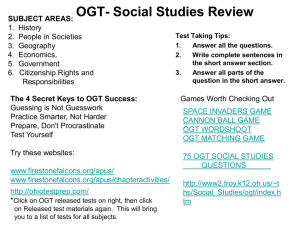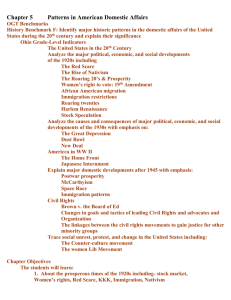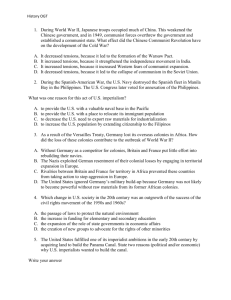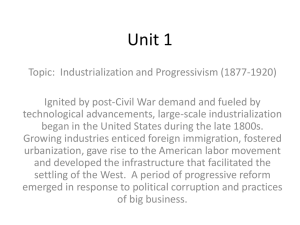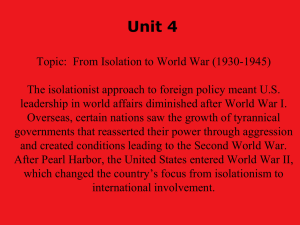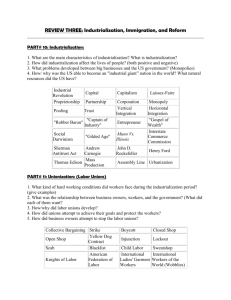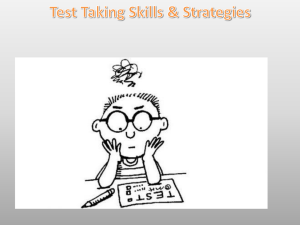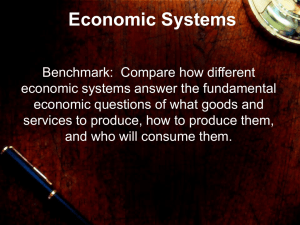OGT Benchmark: Explain the social, political, and economic effects
advertisement
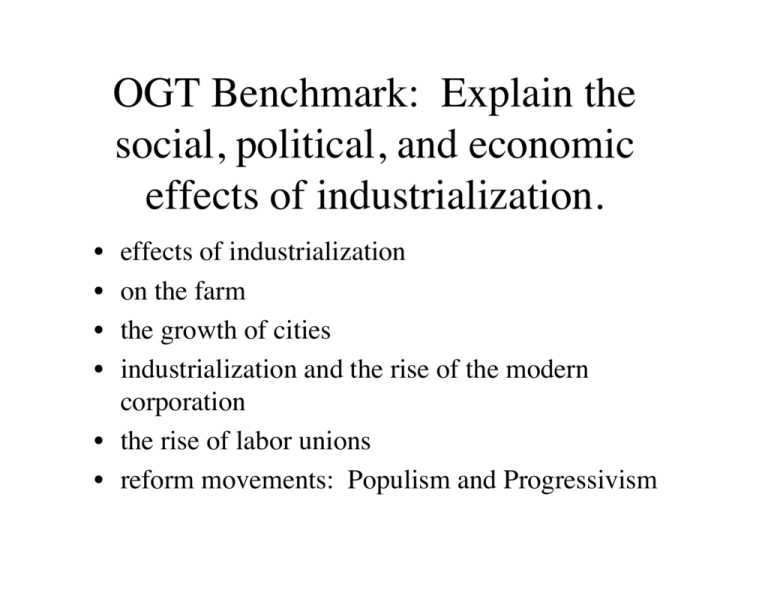
OGT Benchmark: Explain the social, political, and economic effects of industrialization. • • • • effects of industrialization on the farm the growth of cities industrialization and the rise of the modern corporation • the rise of labor unions • reform movements: Populism and Progressivism • This benchmark focuses on the effects of industrialization in the United States after 1877. In the course of leaning about industrialization, you will also encounter its causes. Understanding the causes of industrialization will help you remember the effects. For the purposes of the OGT, however, knowing the effects (results) of industrialization will help you be successful. • For this benchmark, effects of industrialization in the 19th century (1877-1900) include changes in work and the workplace, the impact of immigration and child labor, modernization of agriculture, urbanization, and the growth of the middle class and its effect on cultural life. Economic and political effects of industrialization in both the 19th and 20th centuries include the development of corporations, laissezfaire economic policies, monopolies, changes in the standard of living , and the growth of labor unions. • Reform movements in the late 19th and early 20th centuries were another response to industrialization, especially the Populists and the Progressives. The goals and achievements of these reform movements also are part of the story of industrialization in the US. They include urban reforms, the conservation movement, business regulation and antitrust legislation, the public school movement, and the regulation of child labor. 40 Percent of World Production in 1913 36 32 35 30 Percent of World Production in 1870 26 25 23 19 20 16 14 15 13 10 10 6 2 5 3 0 Great Britain United States Germany France Belgium Rest of World I. Effects of Industrialization During the 19th Century • Q: What is Industrialization? • A: When workers and immigrants from other countries moved into urban areas (cities) and began to work in the factories. This began in the US in the 1870ʼs. • *During the years after the Civil War, people began to move to the cities. • 1850ʼs: 1 in 5 people lived in the city • 1915: half of all people lived in the city • • • • Effect #1: Cities grew 1. Farmers move to the city a. Find jobs b. Have better lives 2. Immigrants come to the cities a. Most immigrants settled in the city b. Settled together in the cities 3. This created many problems a. overcrowding b. poor housing c. poor sanitation/dirty d. rise in crime Rural and Urban U.S. Population, 1860, 1900, 1920 90 80 70 1860 60 1900 50 1920 40 30 20 10 0 % Rural % Urban Effect #2: US economy became the best 1. immigrants worked AND bought stuff 2. improvements in transportation and communication 3. better technology: machines 4. new business processes: modern corporation 5. tariffs Effect #3 Work and the Workplace 1. Before IR: small business. Everyone knew each other 2. During IR: large factories. Many people operated machines 3. Working conditions a. b. c. d. low pay, long hours, unsafe conditions fierce competition for jobs (immigrants, child labor layoffs no unemployment or disability Effect #4 Living Conditions 1. 2. 3. 4. housing: tenement houses no or poor sewers/water dirty and diseases spread high crime • Effect #5: Working Conditions 1. low pay 2. dangerous machines 3. dark and dangerous factories 4. little or no benefits 5. no worker’s compensation 6. Women and Child Workers – a. women • increased • had to work to make end’s meat • made 1/2 of what men made – b. • • • • children increased worked for less money dangerous conditions child labor laws passed (ignored at first) 1. OGT Multiple Choice • _____ (Practice Test Booklet, 2005) Which of the following was not an effect of the Industrial Revolution? • A. An increasing number of people worked on family farms • B. An increasing number of people lived in cities • C. An increasing number of people worked in factories • D. An increasing number of people left the family farms 2. OGT Multiple Choice • (Base Test March 2005) In the late 19th and early 20th centuries, improvements in steel technology allowed architects to design buildings taller than had previously been possible. As a result, skyscrapers began to be built in cities such as New York and Chicago. • What was the result of this new technology on population patterns in the United States in the first half of the 20th century? • A. decreased growth of suburban areas • B. migration from the West to the Midwest • C. increased migration from urban to rural areas • D. greater population density in urban areas 3. OGT Multiple Choice • _____ (2005 Practice Test) What factor contributed to the migration of large numbers of people from Europe to the United States in the late 19th century? • A. Economic prosperity in Europe allowed people to purchase land in the United States • B. Industrialization in the United States attracted laborers from Europe. • C. European social reform movements wanted to spread their beliefs to the United States. • D. The United States needed people to colonize the overseas territories it had recently acquired. 4. OGT Multiple Choice • _____ (2005 Practice Test) In the late 19th and early 20th centuries, many immigrants who came to the United States did not speak English as their native language. One way this resulted in the exchange of cultural practices was that • A. words from other languages entered into the mainstream vocabulary • B. people from other countries tended to remain culturally isolated • C. people without knowledge of English were not allowed to immigrate • D. most people were able to speak several languages fluently 5. OGT Multiple Choice • _____ (Practice Test Booklet, 2005) Which of the following best explains the impact immigration has had on the American diet? • A. Fast food restaurants have sprung up all over the United States • B. There is great variety of types of restaurants serving ethnic foods • C. There are very few choices of different ethnic foods in restaurants • D. Americans eat the same food almost everyday 6. OGT Multiple Choice • _____ (Base Test March 2005) One effect of industrialization in the United States in the late 19th century was • A. a decrease in immigration to the United States • B. an increase in demand for handicraft goods • C. a decrease in child labor • D. an increase in urbanization 7. OGT Multiple Choice • _____(Practice Test Booklet, 2005) The consequences of urbanization often include all of the following EXCEPT • A. increased pollution of air and water • B. more people living in crowded conditions • C. more people farming • D. more jobs in factories and businesses 8. OGT Multiple Choice • _____ (Practice Test Booklet, 2005) Immigration impacts language in the United States because it • A. causes the official language to change with each new immigrant culture • B. results in English speaking people resisting new words • C. infuses new words into the language • D. maintains the current language without change OGT Extended Response • How did industrialization in the United States affect family life? In what ways would working in a factory in the 1880ʼs compare to working in a factory today? II. On the Farm Technology: modernized the farms 1. Railroads A. Transport goods B. Transcontinental--1869 C. By 1900, several transcontinental RR’s D. 1880: 93,000 miles of track E. 1900: 193,000 miles of track • 2. – – – – – – New Invention Help Farmers a. b. c. d. e. f. 1875--refrigerated railroad cars McCormick reaper thresher steel-tipped plow combines (reap, thresh, and clean grain) fertilizer – ***All of these allowed farmers to grow more crops with less labor in a short period of time. Food could also be transported all over the country! The McCormick Reaper http://unitedstreaming.com/ • Let’s look at this video on new inventions during the Industrial Revolution • Length is 4:11 OGT Extended Response • The Industrial Revolution brought about major changes not only in cities, but in rural America as well. Explain two ways farming changed as a result of the Industrial Revolution. (4 points) OGT Extended Response • How did agricultural tools and machines invented in the 19th century make it possible for American cities to grow rapidly in the late 1800ʼs. (4 points) 1900: 40% lived in urban areas 1915: 50% 1920: over 50% in cities (1st time ever!) Where did they come from? 1. immigrants 2. the farms 3. African-Americans from the south (Jim Crow laws) • A. Urban Problems • • • • 1. Tenement houses a. Hold as many families as possible b. Poor immigrants lived there c. Bad conditions • • • • 2. Dirt, disease, and crime a. Bad plumbing: flies and germs b. No bathtubs with running water c. Tuberculosis was common d. “Murdererʼs Alley” and “Misery Lane” http://www.unitedstreaming.com/ Let’s look at a video clip from United Streaming on Getting Out of the Slums: Immigrants Turning to a Life of Crime This clip is 3:39 in length. • middle class grew • more office workers needed (office workers = white collar; factory workers = blue collar) • engineers and salesmen needed • standard of living increased • enjoyed sports, theater, newspapers in free time OGT Extended Response • Explain four effects of industrialization on living and working conditions for the early industrial working class in the United States in the late 19th century. (4 points) 1. OGT Multiple Choice • (Practice Test Booklet, 2005) Industrialization in the United States resulted in • A. the country becoming more urban than rural • B. workers seeing no need to unite to form labor unions • C. the transformation from an urban to an agrarian society • D. politics not being affected by the economic changes 2. OGT Multiple Choice • _____ (Practice Test Booklet, 2005) Which of the following statements best reflects housing patterns for immigrants soon after their arrival to the United States? • A. They tended to assimilate quickly into the existing communities • B. They tended to spread out quickly into many different communities • C. They tended to congregate into their own communities • D. They tended to leave the United States soon after arriving 3. OGT Multiple Choice • • • • _____ (Base Test March 2005) Consider the following changes that occurred in the United States in the late 19th Century: •Improvements in agricultural production •Increases in immigration from Europe •Advancements in networks of railroad and streetcar lines • • • • • These changes led to the A. rapid growth of urban areas B. acquisition of overseas territories C. elimination of large suburbs around many cities D. movement of people from the urban to the rural areas IV. Industrialization and the Rise of the Modern Corporation • Q: What is a corporation?. • A: New businesses needed money (capital) to start up. A corporation was one way to get that capital. Corporations sell shares of their business, called stock, to the public. If the company does well, stockholders earn a profit. • Examples: railroads, Standard Oil, General Electric A. Corporations • 1. RR 1st to form corporations • 2. many others followed – Ex: Standard Oil, McCormick Company, and General Electric B. Businesses compete • Business leaders looked for ways to make more profit – A. wanted less competition – B. Examples: Oil, coal, and steel industries • 1. Create monopoly or trusts (no competition) –combined many small companies into 1 large company = less competition = charge higher prices = more $$$$$$$$$ B. Examples of Monopolies 1. J. Pierpont Morgan • A great organizer • Bought many businesses, including Carnegie Steel • Controlled many RR’s • Worth billions • Banking mogul 2. Andrew Carnegie • Childhood A. Poor B. Educated himself C. Became millionaire • Steel monopoly • Gave a lot away A. Colleges B. Libraries • Pittsburgh 3. John D. Rockefeller sets up the Standard Oil Company A. ambitious B. great organizer C. Cleveland 1. great place to start oil business a. by a lake b. many railroads Rockefeller continued…. • Bought oil refineries • • 1. 1st in Cleveland 2. bought others in other areas D. Laissez-Faire Policies • Q: What is laissez-faire? • A: The government allows the people to do as they choose • Laissez-faire allowed for: – 1. no gov. regulation of business – 2. wages and working conditions were unregulated – 3. no environmental regulations to control pollution – 4. allowed for the rise of monopolies Do You Agree With Laissez-Faire??? • Pros • Gov. can’t tell owner what to do • Business owner would make more money • Cons • Gov. could shut business down if they did bad things (unsafe, pollution, etc.) • have to make business safer • better working conditions (higher pay, shorter hours, insurance, etc) Write a position paper for or against laissez-faire. OGT Short Answer • Why did corporations favor laissez-faire policies? • Industrialization raised the standard of living for many – – – – a entreprenuers (business owners) b. the middle class c. managers d. many new inventions (United Streaming Video) – What about blue- collar workers?? 1. OGT Multiple Choice • _____ (Blue Book, 2005) Laissez-faire theory argued that • A. poverty was nautral and unavoidable • B. corporations required regulation • C. government intervention was necessary • D. the market was self-regulating OGT Extended Response • During the industrial era of the late 1800’s in the United States, monopolies began to grow. A monopoly means there is no competition in a given business. • •List 2 men during this era who had a monopoly and describe their business. (2 pts) • •Do you believe monopolies were good or bad for the American economy? • Describe your answer. (2 pts) V. The Rise of Labor Unions • A labor union is workers who join together to get better conditions and more money. 1. Workers Unite to Improve Working Conditions • a. unsafe conditions • b. low pay • c. long hours • d. child labor 2. Owners resisted the unions a. violence • 3. Strikes a. The Power of the Strike--a strike is when workers refuse to work. • b. They do not get paid, but the company also does not make any money. • • c. The company could hire strikebreakers--they were hired to take the place of the striking workers. Fights would often break out between the workers and the strikebreakers. 4. The First Unions A. The Knights of Labor 1. began in 1869 by Uriah Stephens 2. It started off small, but then grew 3. Terrence V. Powderly became the leader--memberhsip grew 4. This union included any worker who wanted to be in it. 5. This union grew to over 700,000 members. B. The American Federation of Labor 1. started in 1886 by Samuel Gompers. 2. for skilled workers only a. Skilled workers were carpenters, bricklayers, etc. *Both wanted better pay and working conditions for its members! 5. Haymarket Riots A. The Haymarket Square Bombing -Chicago -80,000 workers went on strike -Fights broke out -police were called in. -police killed a couple of the strikers. -someone threw a bomb into the crowd and others were killed. -Many people blamed the Knights of Labor for this. -Membership in unions declined after this riot. 80% 70% 60% 50% 40% 30% 20% 10% 0% 1867 1914 AF of L Independent Unions 1. OGT Multiple Choice • _____ (Practice Test Booklet, 2005) During the late 1800ʼs and early 1900ʼs, labor unions in the United States have been interested in all of the following EXCEPT • A. higher wages • B. longer work week • C. safer working conditions • D. shorter work week OGT Extended Response • Analyze reasons for the rise and growth of labor organizations (Knights of Labor, American Federation of Labor) in the United States. (4 pts) OGT Extended Response •What are two things workers must do to make a strike successful? (2 points) •In your opinion, are unions good? Why or why not? (2 points) IV. Reform Movements: Populism and Progressivism • Q: What is reform? • A: Reform means to make changes for the better • During the IR, Many people believed there were corrupt things going on. Those who tried to change these evils were known as reformers. • Reformers usually joined either the Populist Party or the Progressive Party. A. Populists • 1. Populism was mostly an agrarian movement (farmers) • 2. wanted gov. to take over railroad • b. RR owners made prices too high for farmers to ship goods • 3. prices were too low--overproduction due to new technology • 4. *Populists want gov. help for farmers! • B. The Granger Movement • • • • • • • The farmersʼ revolt During Civil War, farmers prospered. Now, a bushel of wheat sold for 49 cents (used to sell at $1.21 during Civil War) Other prices went down. Farmers were poor and many lost their farms. *Farmers formed the “Granges” A. national farm organization B. similar to labor unions C. wanted help from the government to get them out of debt At meeting halls, like this one near Murphysboro, Grange members gathered to plan improvements for the agriculture industry C. Farmers’ Alliance • By 1890’s Grangers declined, Farmers’ Alliance takes over. – – – – – – a. b. c. d. e. f. 1.5 million members became more political wanted strict regulation of RR’s policy to allow farmers to easily pay debt low interest loans for farmers government-ran storage facilities D. The Progressive Movement • The Progressive Movement was an urban, middle-class reaction to social and economic dislocations fostered by the growth of the United States as an industrial power. E. Progressive Reformers • 1. fight business corruption • 2. fight monopolies – a. New laws would regulate big business • 3. better living conditions • 4. strengthen political system – a. Voters will have more say in selecting candidates • 5. Many people involved in progressive movement • F. Muckrakers • • • • • A. Journalists 1. Named by Teddy Roosevelt 2. They looked for corruption 3. They made up stories of corruption 4. Everybody read their stories • • • • • 1. Lincoln Steffens “Tweed Days in St. Louis” a. misgovernment in the city Shame of the Cities He was a feared writer • • 2. Ida Tarbell • * She bashed John D. Rockefeller and Standard Oil • a. it ruined her fatherʼs business • 3. Upton Sinclair--most famous muckraker • • 1. The Jungle 2. Exposed the Meat Packing Industry • These writers got their message to everybody. Millions bought newspapers and magazines to read the muckrakersʼ stories. This led to even more REFORM!!!! The Jungle by Upton Sinclair The Jungle • • • • • • • • • • • G. Government Reforms A. Meat Inspection Act--gov. had right to inspect meat 1. The Jungle by Upton Sinclair B. Pure Food and Drug Act 1. manufacture and sale of impure foods, drugs, and liquors was forbidden C. Employersʼ Liability Act 1. provided accident insurance for railroad workers D. Strengthen Interstate Commerce Commission 1.They would regulated RR • • • • E. Newlands Reclamation Act 1. Money from sales of land in west would go to build dams and canals 2. This allowed for dry areas to get water • • • • • • • • • • F. Other state reforms a. child-labor laws b. workmenʼs compensation c. insurance for sick, old, and disabled d. minimum wages e. By WWI, 26 states were “dry” f. changed tax laws to heavily tax: -the rich -big businesses -inheritance • • • • • • • • • • • • • • • • • • • • • • • • G. Direct democracy and womenʼs suffrage A. Australian ballot 1. Secret ballot 2. Used to help stop political bosses B. Direct primary 1. Mississippi and Wisconsin used it first (1902) 2. Each party candidates voted by people C. Seventeenth Amendment 1. Direct election of Senators a. no longer by state legislatures b. no longer “Rich Manʼs Club” D. Initiative 1. the people can start a bill 2. takes 5 to 8% E. Referendum 1. a direct vote from the people to make a new law or change an old law F. Recall 1. the people could replace an elected official Example: 2003 California used the recall to replace the governor (Gray Davis) with Arnold Schwartzenegger. G. Womenʼs suffrage (19th amendment finally in 1920) 1. Progressives believed women would help 2. 1896: 4 states 1914: 7 more states H. Child Labor Legislation • Progressives want gov. to regulate • 1916: Keating-Owen Act--set age limits • 1938: Fair Labor Standards Act--set up even more strict child labor regulations • Progressives were able to fix many of the evils going on during the Industrial Revolution 1. OGT Multiple Choice • _____(Base Test March 2005) The 1890 U.S. Census led some people to conclude that there was no longer a frontier line in the West. Early in the 20th century, President Theodore Roosevelt advocated the conservation of the nationʼs natural resources. These events signaled a change in how people perceived • A. urban areas • B. farmland • C. wilderness areas • D. centers of industry and technology 2. OGT Multiple Choice • _____ (Blue Book, 2005) Which of the following groups favored a civil service system? • A. Progressives • B. immigrants • C. political machine bosses • D. railroad owners 3. OGT Multiple Choice • _____ (2005 Practice Test) Progressive reformers after 1900 sought to regulate working conditions and to set a minimum age for child labor. The need for this legislation was prompted by • A. Civil War casualties leading to children taking the jobs of others • B. unions restricting membership to adult workers • C. industrialists using child labor to keep production costs down • D. lack of job opportunities for children seeking afterschool jobs 4. OGT Multiple Choice • _____ (2005 Practice Test) In 1872, as part of a state-bystate campaign for womenʼs suffrage, Susan B. Anthony knowingly and deliberately violated New York state law by casting a ballot in the presidential election. She was tried, found guilty, and ordered to pay a fine. • What was the purpose of Susan B. Anthonyʼs act of civil disobedience? A. to gain support for a particular candidate B. to use propaganda to influence public opinion C. to call attention to a perceived injustice D. to show that unjust laws could not be enforced • • • • 5. OGT Multiple Choice • • • • • ______ (Practice Test Booklet, 2005) In the late 19th century, farmers in the United States responded to the changing economy in which of the following political movements? A. Civil Rights B. Abolitionist C. Populist D. Progressive 6. OGT Multiple Choice • _____ (2005 Practice Test) How did the U.S. Constitution change as a result of the ratification of the 19th Amendment? • A. The right of suffrage was extended to women. • B. Freedom of assembly was restricted • C. The power of government decreased • D. Freedom of the press was strengthened 7. OGT Multiple Choice • • • • • _____ (Base Test March 2005) During the Industrial Revolution of the late 19th century, farmers in the United States worked to increase their land holdings and modernize their equipment. A lasting effect of these changes was A. higher prices for crops B. increased rural population density C. a shortage of land for farming D. greater productivity of farming 8. OGT Multiple Choice • _____ (Blue Book, 2005) The Progressive movement is best defined as • A. an organized political party with a clear-cut set of goals • B. an idea that favored government reforem of social abuses • C. pro business and antiunion • D. made up mostly of minorities and labor unoin members 9. OGT Multiple Choice • _____ (Blue Book, 2005) The Populist Party program • A. was so impractical that none of it was ever enacted • B. wanted to prohibit government intervention in the economy • C. Favored laissez-faire policies to help corporations • D. favored government regulation of railroads THE END • This concludes our unit on Industrialization. Next, we will look at the United States and IMPERIALISM
